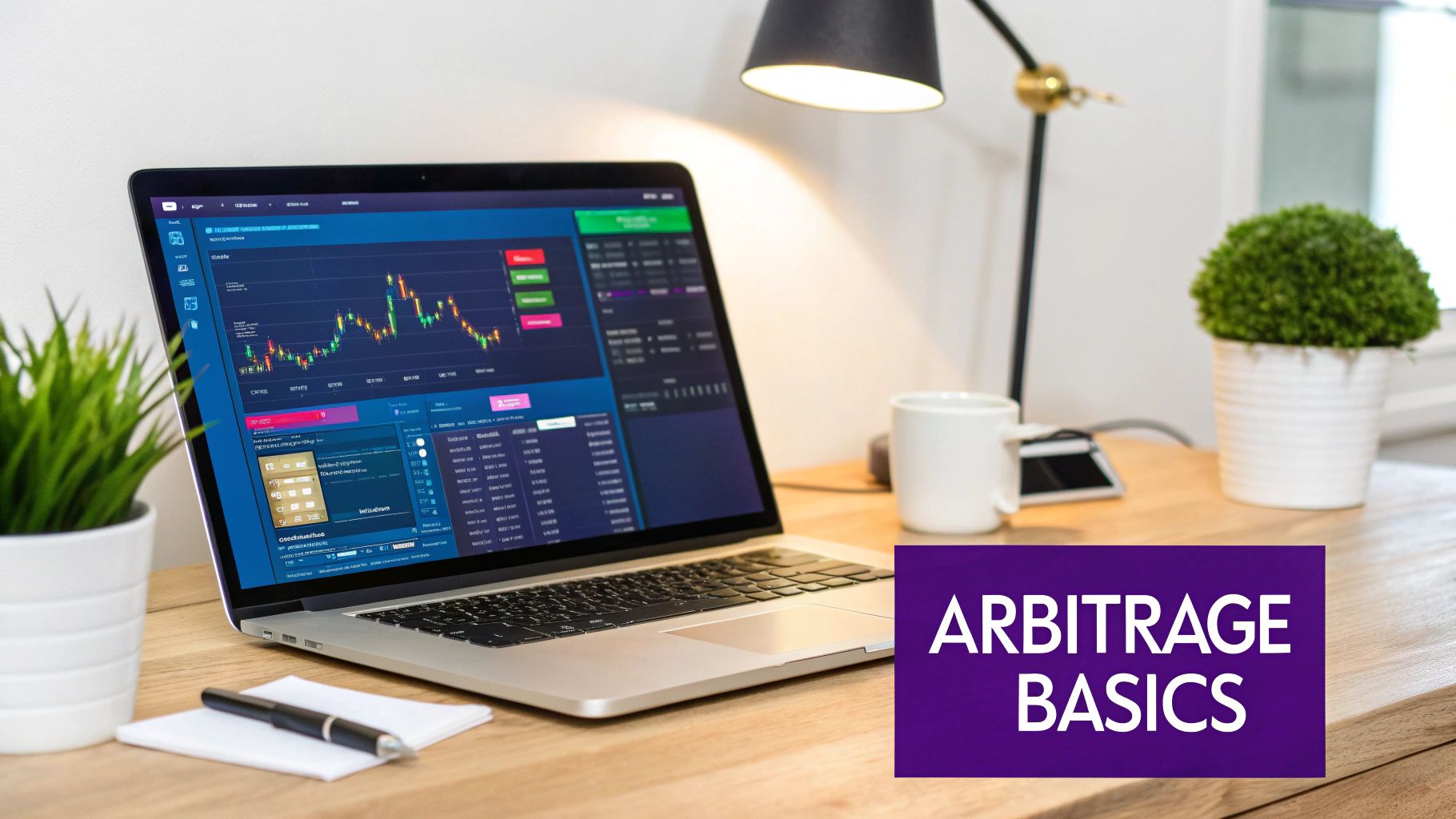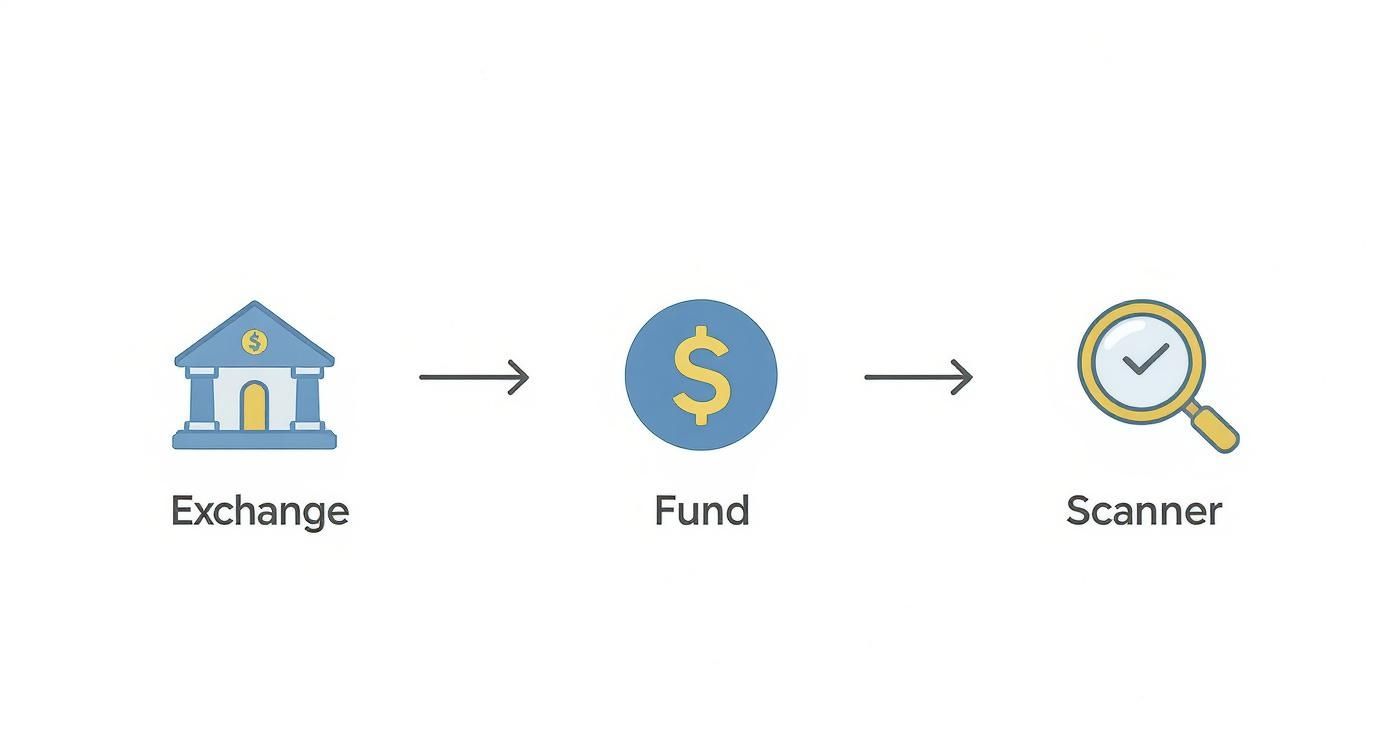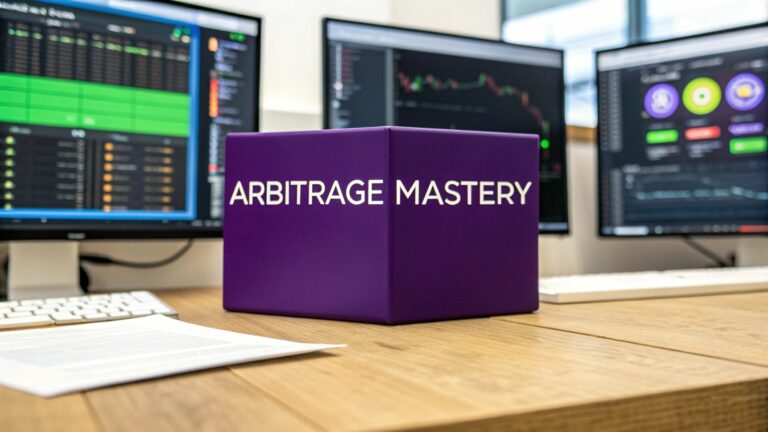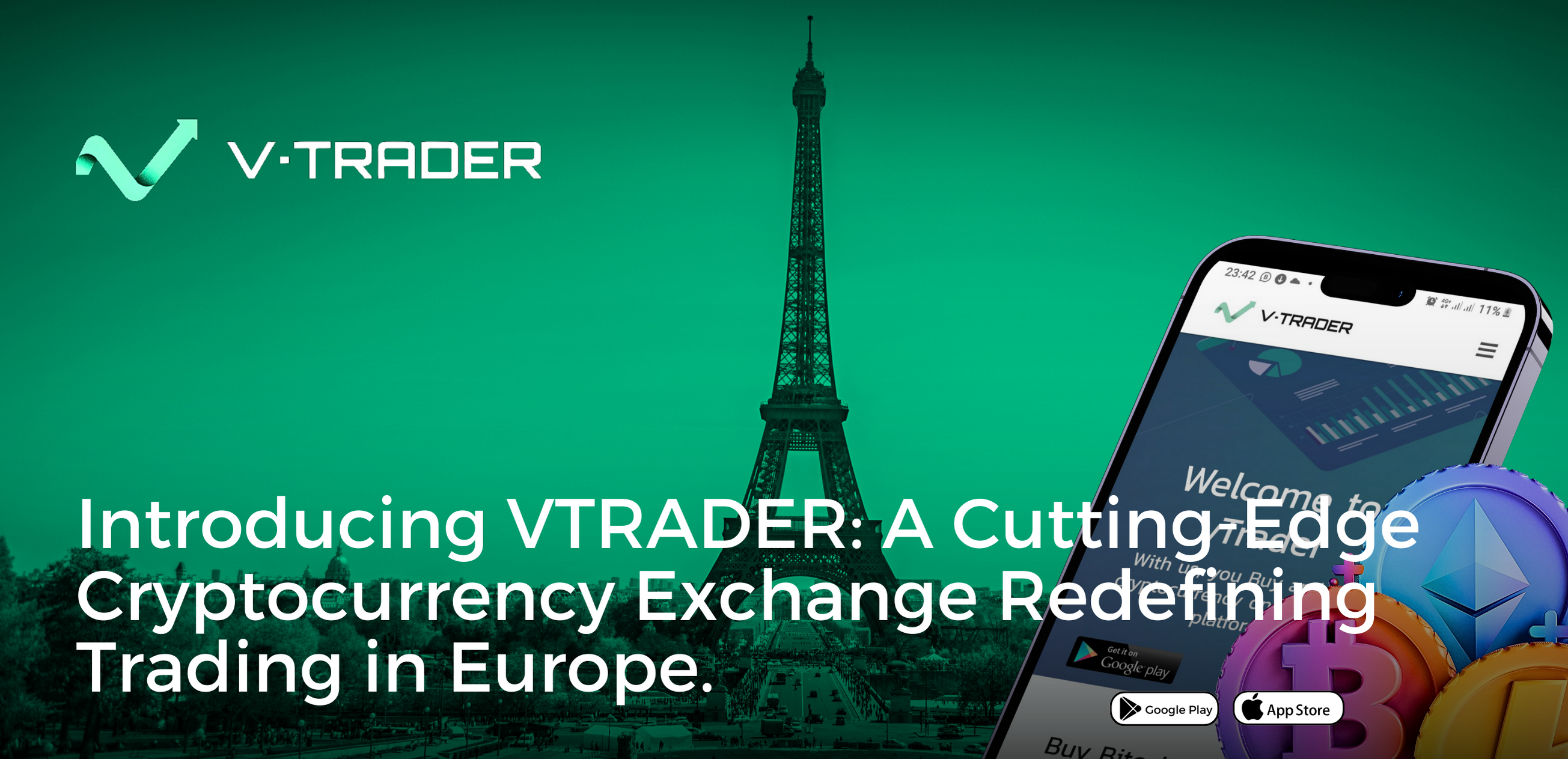At its heart, cryptocurrency arbitrage trading is a pretty simple concept: you buy a crypto asset on one exchange where it’s cheap and immediately sell it on another where the price is higher. It’s all about capitalizing on temporary price differences across the global market.
Imagine finding a product for sale at $10 in one shop and seeing it listed for $12 in a shop next door. You'd buy it from the first and sell it to the second for a quick $2 profit. That's arbitrage in a nutshell.
Understanding Crypto Arbitrage Opportunities

This kind of opportunity only exists because the crypto market is so fragmented. Unlike the stock market, which has central exchanges like the NYSE setting the price, crypto trades on hundreds of independent platforms worldwide. Each one has its own liquidity, order book, and trading volume, which inevitably leads to small but frequent price gaps for the same exact asset.
The catch? These opportunities don't last long. We're talking seconds or minutes before the market naturally balances itself out. This makes speed and efficiency absolutely critical to your success.
The Three Pillars of Arbitrage Strategy
To really get into arbitrage, you need to understand the main ways traders actually capture these price gaps. Each method targets a different kind of market inefficiency, so it pays to know the playbook.
- Spatial Arbitrage: This is the most common and straightforward type. You simply buy a coin on Exchange A (where it's cheaper) and sell it on Exchange B (where it's pricier). It’s called "spatial" because the trade crosses different digital locations.
- Triangular Arbitrage: This one is a bit more complex because it all happens on a single exchange. It involves a three-way trade between different cryptocurrencies to end up with more of your starting asset. For instance, you could trade USD for BTC, then flip the BTC for ETH, and finally sell the ETH back into USD, pocketing a small profit from tiny mispricings between the pairs.
- Statistical Arbitrage: This is the high-tech, algorithm-driven approach. It relies on sophisticated mathematical models to spot statistical mispricings between related assets. When one coin deviates from its usual price relationship with another, the bot jumps in, betting that prices will eventually revert to their normal pattern.
To make these distinctions clearer, here’s a quick breakdown of how they stack up against each other.
Core Cryptocurrency Arbitrage Strategies at a Glance
| Strategy Type | Core Mechanism | Primary Requirement | Example Scenario |
|---|---|---|---|
| Spatial | Buy low on Exchange A, sell high on Exchange B. | Accounts with funds on multiple exchanges. | BTC is $60,000 on Kraken but $60,150 on Binance. |
| Triangular | Trade through three pairs on one exchange (e.g., USD → BTC → ETH → USD). | Real-time calculation of cross-rates. | Exploiting a momentary price imbalance in the BTC/ETH pair relative to USD. |
| Statistical | Use algorithms to find and trade price deviations from a historical norm. | Advanced quantitative models and automation. | Two correlated altcoins diverge in price; a bot shorts the overpriced one and buys the underpriced one. |
Each strategy has its place, but the right one for you will depend on your capital, technical skills, and how fast you can act.
Why Profit Margins Are Shrinking
Let's be clear: the arbitrage game has changed. Crypto arbitrage trading in 2025 is a far cry from what it was just a few years ago. The market has gotten smarter and much more efficient.
Back in 2021-2023, it wasn't unheard of to find double-digit percentage differences between exchanges. Those days are largely gone. Now, a typical opportunity offers a much tighter spread of about 0.1% to 2%. This squeeze means you either need to trade with much larger amounts of capital or execute a higher volume of trades to see the same kind of returns.
The core challenge in modern arbitrage isn't just spotting a price difference; it's executing the trade fast enough and with costs low enough to capture the razor-thin profit before it disappears.
This is exactly why platforms with zero trading fees, like vTrader, have become such a game-changer. When your entire potential profit is just a fraction of a percent, standard commissions can wipe it out instantly. Eliminating fees gives you an edge that can be the difference between a winning trade and a losing one.
The principles of arbitrage are universal, and you can see how they apply in other markets by learning how to arbitrage bet for consistent profit. And if you're still building your core trading skills, our guide on how to learn crypto trading is a great place to start.
Assembling Your Arbitrage Trading Toolkit
Knowing the theory is great, but making money with crypto arbitrage comes down to having the right setup. Moving from seeing an opportunity to actually executing a profitable trade requires a specific set of tools and a bit of prep work. Think of it like a workshop—you need to have everything in place before you can start building.
Your first, most critical task is to get accounts on multiple exchanges. You simply can't do spatial arbitrage, the most common type, without being set up on at least two different platforms.
Building Your Exchange Network
Don't just sign up anywhere. You need to be strategic about which exchanges you use. I always look for a few key things:
- High Liquidity: You need exchanges with deep order books. This lets you place larger trades without the price slipping away from you, which can kill your profit margin in a second.
- Low Fees: Margins in arbitrage are already thin. Pay close attention to trading fees (maker vs. taker) and, just as important, the fees for withdrawing your funds.
- Fast Transfers: Time is your enemy. Check an exchange's reputation for how quickly it processes deposits and withdrawals. A slow transfer can turn a winning trade into a missed opportunity.
Once you’ve picked your exchanges, get the identity verification (KYC) process done immediately. This is almost always required for higher withdrawal limits and faster transactions—both are absolutely essential for moving your money when a price gap appears. If you’re just starting out, our guide on setting up your first crypto trading account walks you through every step.
A classic rookie mistake is finding a great trade and then trying to verify an account. By the time you’re approved, that opportunity is ancient history. Preparation is everything.
After you're verified, pre-fund your accounts. You need capital sitting on each exchange, ready to go at a moment's notice. A common setup is to hold a stablecoin like USDT or USDC on one exchange and fiat (like USD) on another. That way, you’re not stuck waiting for a bank transfer to clear while your profit window closes.
Essential Tools for Spotting Opportunities
Let's be real: you're not going to find these opportunities by manually refreshing price charts. The market moves way too fast. This is where you bring in specialized tools to act as your eyes and ears, constantly scanning for those profitable price differences.
Your toolkit should have a mix of price aggregators and proper arbitrage scanners.
- Price Aggregators: Sites like CoinGecko or CoinMarketCap are great for getting a big-picture view of an asset's price across different markets. They aren't quite real-time enough for execution, but they're perfect for spotting which exchanges tend to have price deviations for specific coins.
- Arbitrage Scanners: These are the real workhorses. Scanners are tools that plug into multiple exchanges via API and watch the order books in real-time. They do the math for you, factoring in estimated fees and flagging trades that meet your profit criteria.
The right scanner really depends on your budget and how tech-savvy you are. Some are simple web dashboards, while others are advanced scripts you can tweak yourself.
The Advantage of an Integrated Platform
Juggling accounts on multiple exchanges, running an external scanner, and doing profit calculations on the fly adds friction. Every second you spend switching between browser tabs is a second you could be losing money.
This is where an all-in-one platform like vTrader gives you a serious edge.
When you have real-time data feeds and trading tools in one place, you eliminate the frantic switching between apps. But the biggest game-changer is a zero-fee trading structure. High fees are the number one reason why most small price gaps aren't worth trading.
For instance, a 0.5% price difference might look good on paper. But if you're paying a 0.2% trading fee to buy and another 0.2% to sell, your potential profit gets slashed to a measly 0.1%. And that's before you even think about withdrawal or network fees. Platforms that get rid of trading commissions open up a whole new world of smaller, more frequent opportunities that other traders simply can't afford to take.
Executing Your First Manual Arbitrage Trade
Theory is great, but getting your hands dirty is where the real learning happens in arbitrage trading. Let's walk through a manual trade from start to finish to see the mechanics, the pressure, and the hidden costs that can trip you up.
We'll follow a trader, Alex, as they pull the trigger on a spatial arbitrage opportunity.
This is the foundational workflow you need in place before you can even think about capturing a price gap.

As you can see, it all starts with setting up and funding accounts on multiple exchanges. Only then can you start hunting for those price differences—which is exactly where Alex begins.
Spotting the Opportunity
Alex fires up their arbitrage scanner, a tool that keeps a constant eye on asset prices across different platforms. Their accounts on Exchange A and Exchange B are funded and ready to go. They’ve configured the scanner to ping them if it finds any price deviation for Ethereum (ETH) over 1.5%, after accounting for basic trading fees.
Bingo. An alert flashes on the screen:
- Exchange A (Buy): ETH is trading at $3,000
- Exchange B (Sell): ETH is trading at $3,050
At first glance, that looks like an easy $50 profit for every ETH traded. But experienced traders know that the initial spread is just a starting point. The real profit is what's left after every single cost is subtracted.
Calculating the Net Profit
Before clicking a single button, Alex crunches the numbers. The only figure that matters is the net profit. Rushing this step is a classic rookie mistake in cryptocurrency arbitrage trading.
Here’s how the math breaks down for a 1 ETH trade:
-
Trading Fees: Both exchanges charge a 0.1% taker fee. For speed, Alex will use market orders on both ends, making them the "taker."
- Buy Fee (Exchange A): 0.1% of $3,000 = $3.00
- Sell Fee (Exchange B): 0.1% of $3,050 = $3.05
-
Withdrawal & Network Fees: Now, to get the ETH from Exchange A to Exchange B.
- Exchange A Withdrawal Fee: A fixed 0.005 ETH.
- Ethereum Network Gas Fee: The network is a bit busy, so the gas fee is around $5.00.
Let's tally it all up.
| Cost Item | Amount (USD) | Amount (ETH) |
|---|---|---|
| Initial Purchase Cost | $3,000.00 | 1.000 ETH |
| Buy Trading Fee | $3.00 | – |
| Withdrawal Fee | – | 0.005 ETH |
| Network Gas Fee | $5.00 | – |
| Sell Trading Fee | $3.05 | – |
| Total Costs | $11.05 | 0.005 ETH |
After the withdrawal fee, Alex will only have 0.995 ETH (1 ETH – 0.005 ETH) arriving at Exchange B.
Selling that 0.995 ETH for $3,050 brings in $3,034.75.
The moment of truth: $3,034.75 (Sale Revenue) – $3,000 (Initial Cost) – $11.05 (Total Fees in USD) = $23.70 Net Profit.
That promising $50 gap has been cut down to a more realistic $23.70. It's still a profit, so Alex gives it the green light.
The Race Against Time
Now the pressure is on. Every second from this point forward introduces risk.
Alex hits the market buy button for 1 ETH on Exchange A, and the order fills instantly at $3,000. They immediately jump to the withdrawal screen, paste the deposit address for Exchange B, and hit send. The clock is ticking.
The transfer takes eight agonizing minutes to get confirmed on the Ethereum blockchain. During this time, Alex is totally exposed. If the price of ETH on Exchange B were to suddenly drop, that profit could vanish in an instant.
Finally, the ETH lands in the Exchange B wallet. Alex sees the price has held firm, quickly places a market sell order, and watches it fill. The trade is done.
While this trade was a success, it perfectly illustrates the biggest weakness of manual arbitrage: delays. Eight minutes is an eternity in crypto markets. A more seasoned trader might try using different crypto order types, like a limit order, to have more control over their exit price, but that just adds another layer of complexity.
This experience is invaluable. It shows you exactly why automation has become the standard for serious cryptocurrency arbitrage trading. Doing it by hand is a fantastic teacher, but it's a slow and unreliable employee.
Automating Your Strategy with Trading Bots
In crypto arbitrage, speed isn't just a nice-to-have—it's everything. The small, incredibly brief price gaps that create these opportunities can appear and disappear in the blink of an eye. Trying to execute these trades manually, like we walked through earlier, is a bit like trying to catch raindrops. You might snag one or two, but you’ll miss the vast majority.
This is exactly why automation is no longer optional; it's essential. An arbitrage bot is a purpose-built piece of software designed to do one job with brutal efficiency: execute trades at machine speed. By connecting directly to multiple exchanges through APIs, these bots can monitor order books, crunch the numbers on potential profits, and fire off buy and sell orders faster than any human could dream of.
Choosing Your Automation Approach
When you're ready to automate, you'll find there are two main paths you can take. Your choice really boils down to your technical skills, budget, and how much granular control you want over your strategy.
-
Pre-Built, User-Friendly Bots: Think of these as off-the-shelf solutions, often baked directly into trading platforms like vTrader. They give you a straightforward interface where you can set up your trading rules without touching a single line of code. You pick the exchanges, define your minimum profit margin, and the bot takes care of the rest. For most traders, this is the ideal starting point.
-
Custom Scripts and Self-Hosted Bots: If you know your way around programming, building a custom bot offers unparalleled flexibility. With languages like Python, you can design a totally unique strategy, tap into smaller niche exchanges, and fine-tune every last detail of the execution logic. Just be prepared—this route demands serious time for development, testing, and ongoing maintenance.
For most people, a no-code solution is the way to go. It completely removes the technical hurdle, letting you focus on what really matters: strategy and risk management. Platforms like vTrader that integrate these tools are especially powerful. They bring the bot's speed together with real-time data and zero-fee trading, creating the perfect environment for execution. For a deeper look at this, check out our guide to cryptocurrency algorithmic trading.
How Arbitrage Bots Reshape the Market
The rise of these automated tools has completely changed the game. They’ve pushed market efficiency to incredible levels, effectively making it impossible for manual traders to keep up.
The numbers don't lie. In a recent one-year analysis, arbitrage bots were responsible for over 240,000 successful trades, moving around $868.64 million in global volume. These tools systematically hunt down tiny price differences, often locking in profits of just a fraction of a percent on each trade. This is precisely why manual arbitrage is now more of a theoretical exercise than a practical strategy. You can read the full research about bot trading volumes to see the data for yourself.
Putting a Bot to Work: A Practical Scenario
Let's imagine you're trying to pull off a triangular arbitrage trade. This is a complex, three-part trade that is almost impossible to do by hand because of the speed involved.
A bot running on vTrader might spot a momentary price imbalance between BTC, ETH, and USDT on the same exchange. Its real-time logic would kick in instantly, mapping out a sequence like this:
- Trade 1: Use 10,000 USDT to buy Bitcoin (BTC).
- Trade 2: Instantly flip that BTC for Ethereum (ETH).
- Trade 3: Immediately sell the ETH right back into USDT.
A human trader would never be able to calculate the cross-rates and execute all three legs of that trade before the market moved. A bot, however, can complete the entire sequence in milliseconds.
A well-configured bot runs these complex calculations almost instantly. If the final USDT amount is even slightly higher than the initial 10,000 USDT (after fees), the bot executes the entire loop automatically. It captures a tiny profit that a human trader wouldn't have even seen.
This is the real power of automation in crypto arbitrage. It takes complex, high-speed strategies that were once just theoretical and turns them into real, executable opportunities—all without you needing to be a coding wizard.
Navigating Risks and Hidden Costs

Spotting a great price gap is the easy part. The real skill in arbitrage trading is actually capturing that profit before it evaporates.
A juicy 5% spread looks fantastic on paper, but it can shrink to zero—or worse, a loss—once you factor in all the hidden costs and execution hurdles. Think of it like this: your potential profit is a block of ice, and every fee, delay, and market swing is trying to melt it. Your job is to get it from point A to point B with as much ice left as possible.
The Unseen Costs That Erode Profits
Newbie traders get fixated on the price difference and completely forget about the little deductions that bleed profits dry. These costs are the silent killers of a good arbitrage trade, and you have to account for every single one.
Here are the usual suspects:
- Trading Fees: Every exchange charges a fee to buy and sell. Since speed is everything in arbitrage, you’ll almost always be a "taker," which means you're paying the higher fee for an instant market order.
- Withdrawal Fees: Moving your crypto from one exchange to another isn't free. Exchanges charge a withdrawal fee, often a flat amount like 0.0005 BTC, which can really sting on smaller trades.
- Network (Gas) Fees: On top of withdrawal fees, you have to pay the blockchain’s own transaction fee. For networks like Ethereum, these "gas" fees can spike unexpectedly and turn a profitable trade into a money-loser all on their own.
A classic mistake is only calculating the trading fees. You have to add up the trading, withdrawal, and network fees to find your total transaction cost. If you don't, you're flying blind.
For a deeper dive into these expenses, check out our guide on understanding crypto trading fees and how they work.
Execution and Timing Risks
Beyond the fixed costs, you have to deal with the chaos of the live market. Time is your biggest enemy here. Every second that ticks by introduces risk and uncertainty.
Two major execution risks can wreck your trade:
- Slippage: This is the price difference between when you click "buy" and when your order actually fills. On exchanges with low liquidity or during wild market swings, a large order can "slip," meaning you get a much worse price than you expected.
- Transfer Time Risk: This is the big one for spatial arbitrage. When your funds are moving between exchanges—a process that can take minutes or even an hour—you're completely exposed. If the price crashes on the destination exchange while your crypto is stuck in transit, your profit is gone.
Strategies for Mitigating Risk
You can't eliminate these risks completely, but you can definitely manage them. One smart move is to use faster blockchains or stablecoins for transfers. Sending USDT on the TRON network, for example, is usually way faster and cheaper than sending ETH on the Ethereum mainnet.
But the single best way to protect your profits is to cut costs at the source. This is where a platform like vTrader gives you a serious edge.
By offering zero-fee trading, vTrader completely removes one of the biggest variables from your profit equation. This lets you pounce on smaller, more frequent price gaps that are simply unprofitable for traders paying high commissions.
The global crypto market is massive, with exchange volume hitting an incredible $9.36 trillion in the first half of 2025. Bitcoin alone sees an average of $96 billion in daily trades. This firehose of activity creates endless micro-opportunities, but the margins are razor-thin. To succeed, as you can discover in more detail here, you absolutely need automation and fierce cost control.
Common Questions About Crypto Arbitrage
Once you start looking into crypto arbitrage, a few key questions always come up. Let's dig into the practical side of things and clear up the most common points of confusion.
Is Cryptocurrency Arbitrage Trading Still Profitable?
Absolutely, but the easy money is long gone. The wild west days of finding massive, double-digit price gaps and executing them manually are over. Today’s game is all about speed and volume.
Success in modern arbitrage means making a high number of trades on razor-thin margins, often between 0.1% and 2%. Instead of hunting for one huge payday, traders now capture hundreds of tiny profits that add up. This approach demands serious speed, a decent amount of capital, and—most importantly—rock-bottom fees. It’s exactly why zero-fee platforms and automated bots are no longer a luxury but a necessity.
How Much Capital Do I Need to Start?
There's no magic number, but you need enough capital to make the tiny profits matter. A 0.5% gain on a $100 trade is only $0.50, which gets eaten alive by withdrawal or network fees.
That same 0.5% profit on a $10,000 trade, however, turns into a much healthier $50. Most serious traders keep thousands of dollars ready to go across several exchanges. This liquidity is crucial—it lets them pounce on an opportunity instantly instead of waiting for a bank transfer to clear. A good rule of thumb is to start with an amount you’re okay with losing, then scale up as you refine your strategy and build confidence.
What Are the Biggest Risks in Arbitrage Trading?
Even a perfect opportunity can turn into a loss if you're not careful. The three biggest killers are execution risk, transfer risk, and getting your fees wrong.
- Execution Risk (Slippage): This happens when the price moves against you in the split second between spotting an opportunity and your order actually getting filled.
- Transfer Risk: This is the classic trap of moving crypto between two exchanges. A slow network confirmation can completely wipe out your profit margin while you wait.
- Fee Miscalculation: This one is a rookie mistake but incredibly common. If you don't account for every single fee—trading, withdrawal, and network gas—you'll find yourself losing money on "profitable" trades.
Managing these risks comes down to precise, upfront calculations and executing trades as fast as humanly (or robotically) possible.
Do I Need to Know How to Code to Use an Arbitrage Bot?
Not anymore. Automation has become way more accessible, and there are tools for just about every skill level.
You don’t have to be a developer to leverage the power of automation. Many platforms offer user-friendly interfaces that let you configure powerful trading strategies without writing a single line of code.
Here are your main options:
- Off-the-shelf bots give you a simple dashboard where you can set up your strategy with a few clicks.
- Script-based bots offer more flexibility. Some platforms let you customize them with languages like Python.
- For total control, you can build your own bot from scratch using exchange APIs, but this is for advanced traders.
For most people starting out, a no-code or low-code platform is the best way to get in the game and compete.
Ready to put these strategies into practice without fees eating into your profits? With vTrader, you get zero-fee trading, real-time data, and the integrated tools you need to succeed in crypto arbitrage. Sign up today and start trading smarter.

Steve Gregory is a lawyer in the United States who specializes in licensing for cryptocurrency companies and products. Steve began his career as an attorney in 2015 but made the switch to working in cryptocurrency full time shortly after joining the original team at Gemini Trust Company, an early cryptocurrency exchange based in New York City. Steve then joined CEX.io and was able to launch their regulated US-based cryptocurrency. Steve then went on to become the CEO at currency.com when he ran for four years and was able to lead currency.com to being fully acquired in 2025.


